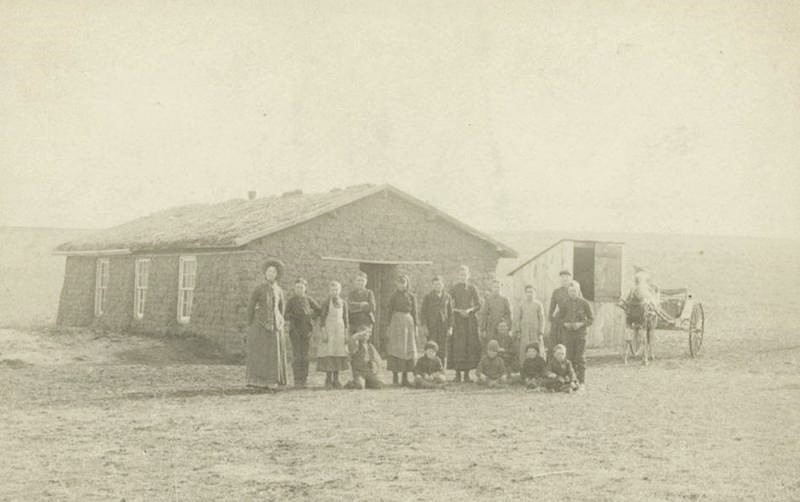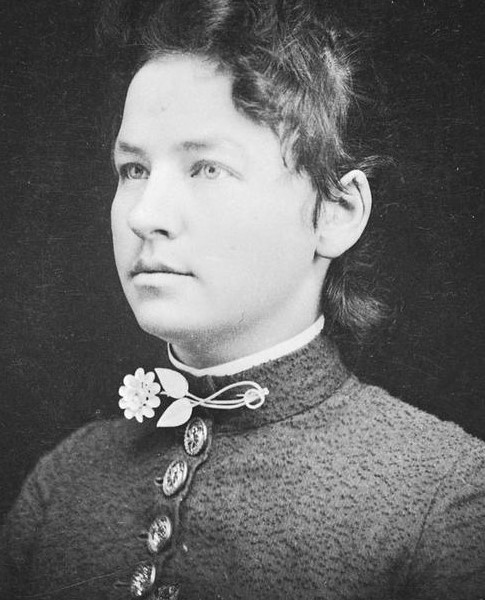Ray Hahn
Minnie Freeman’s Most
Notable Day of Teaching
In a genealogy workshop, one of my students was telling a family tale that she heard around 1955 from her grandmother. It was about her Great Uncle’s birth in 1888. Supposedly the birth took place during a weather event frequently referred to as the Blizzard of ’88. Another member of the group spoke up and said that she had read about it and the article told about how a Nebraska schoolteacher saved the lives of thirteen children.
There are many stories about 1888 snowstorms, so to prevent the inevitable confusion please indulge the following explanation.
The conversation described above concerned two different storms. The birthday story took place in March 1888. The blizzard, also known as the Great White Hurricane, started on March 11th and raged without pause for three days. At the worst of it, the eye of the storm was centered over Narragansett Bay in Rhode Island. During the storm between 10 and 58 inches of snow fell on most of the states from Virginia to Maine. It is among the most severe blizzards in American history. The Nebraska story was recorded in newspapers from Massachusetts to California and nearly every state in America’s northeast. Many of those involved, a teacher, Minnie Freeman of Mira Valley, Nebraska and thirteen of her students were photographed in November of 1887. That photo later appeared on a real-photo postcard. It is this, a story of the Schoolchildren’s Blizzard of January 12, 1888, that follows.

Miss Minnie Freeman with her class, circa November 1887

Minnie Freeman, about age 20
According to one account, the weather was unseasonably warm on January 12, 1888, it was in the 40s and many were out doing errands and enjoying the sunshine. Minnie Freeman made her way to the Mira Valley School in rural Nebraska, where she was the teacher.
A short time later, Miss Freeman’s students, ages 5 to 16, arrived and the lessons began. The morning ended on a high note.
During their lunch an unexpected snowstorm blew in from the west. Within minutes, the temperature dropped to below zero, the snow mixed with hail and sleet was heavy and the winds were so intense that the door of the school was torn off its hinges.
Miss Freeman realized that she must act quickly and as the tarpaper roof was torn away by the wind, there was soon as much snow inside the school as there was outside. It was a life-threatening emergency.
When examined with the 20/20 vision of hindsight, Miss Freeman’s next step was just short of genius. She retrieved the “tug-of-war” rope from the classroom’s toybox and tied each child with the rope then wrapped the end around herself. She scooped up the five-year old in her arms and shouted over the noise of the wind for her students to follow. Freeman led her students into the storm for a dangerous mile-long trek to safety.

A souvenir card of Minnie Freeman’s Most Important Day of Teaching
“I’ve never felt such a wind,” she said later while recounting her actions, “It blew the snow so hard that the flakes stung your face like arrows. All you could see ahead of you was a blinding, blowing sheet of snow.”
Freeman and her rope-line of children found refuge in a farmhouse. All accounted for without injury but chilled to their tiny bones. The warmth of the fireplace, the hot drinks they were given, and the quilts they were wrapped in were welcomed with shouts of glee and very wide smiles.
Minnie Freeman would later learn that the storm turned deadly in many parts of the mid-west, but she and her students were safe and in the arms of their parents. And because her heroism captivated the country’s attention, she earned the nickname of “Nebraska’s Fearless Maid.” It is alleged that she received several marriage proposals, many gifts from admirers and hundreds of letters praising the defense of her students.

In April 1891, Freeman, then in her early twenties, married Edgar B. Penney, 25, in Omaha. They lived in Fullerton, Nebraska, where they raised two sons, Freeman and Frederick.

Throughout Mrs. Penney’s later life, she continued her public service as a political activist and as a member of several State of Nebraska ad hoc action committees.
Mrs. Penney died in Chicago on Monday, November 1, 1943. Obituaries were filed with dozens of mid-west newspapers; each recounted the occasion of her heroic act fifty-five years earlier.
Other accounts of the snow event have been logged at the Nebraska Historical Society, along with photos and oral-history interviews of her sons, her grand- and great-grandchildren, and others who knew her. A particularly poignant one was the mother who made her way to the school the next morning and found it destroyed and empty. Thinking that all were lost in the storm and completely grief-stricken she readied herself to return home alone. Then the glee she experienced when she caught sight of all the students, safe and sound, marching across a field led by their teacher, Miss Minnie Freeman.
Miss Freeman’s resourceful and dramatic rescue was immortalized in a Victorian parlor song, Thirteen Were Saved; Or Nebraska’s Fearless Maid, by the composer William Vincent. She is also featured in a mosaic mural in the Nebraska State Capitol. But throughout her life, the schoolteacher said on many occasions, that she never desired the attention she received, “Too much was made over an act of simple duty.”
My topical sheet music collections include songs about natural disasters, accidents, plane and train wrecks. Sentimental audiences must have liked this material for decades, otherwise why would talented composers write this stuff? I have included some music in a few articles for Postcard History. Thank you for adding a nice g0-with that I have never seen before. Earthquakes, volcanos, the Johnstown Flood, the Triangle Shirt Factory fire, the Iroquois Theater fire, Floyd Collins in the cave, Lizzy Borden (Whack, Whack, Whack), and numerous train wrecks were some subjects. I wonder how many copies were sold. Were people so starved for… Read more »
An interesting story I had never heard about until today.
Being from Nebraska I have heard the 1888 stories often, but did not realize there would be a postcard and sheet music (which I collect as well) tied to this event. We are always learning. Thank you for sharing your article.
curious. How did Minnie die? I found she and her husband, Edgar, passed away on the very same day